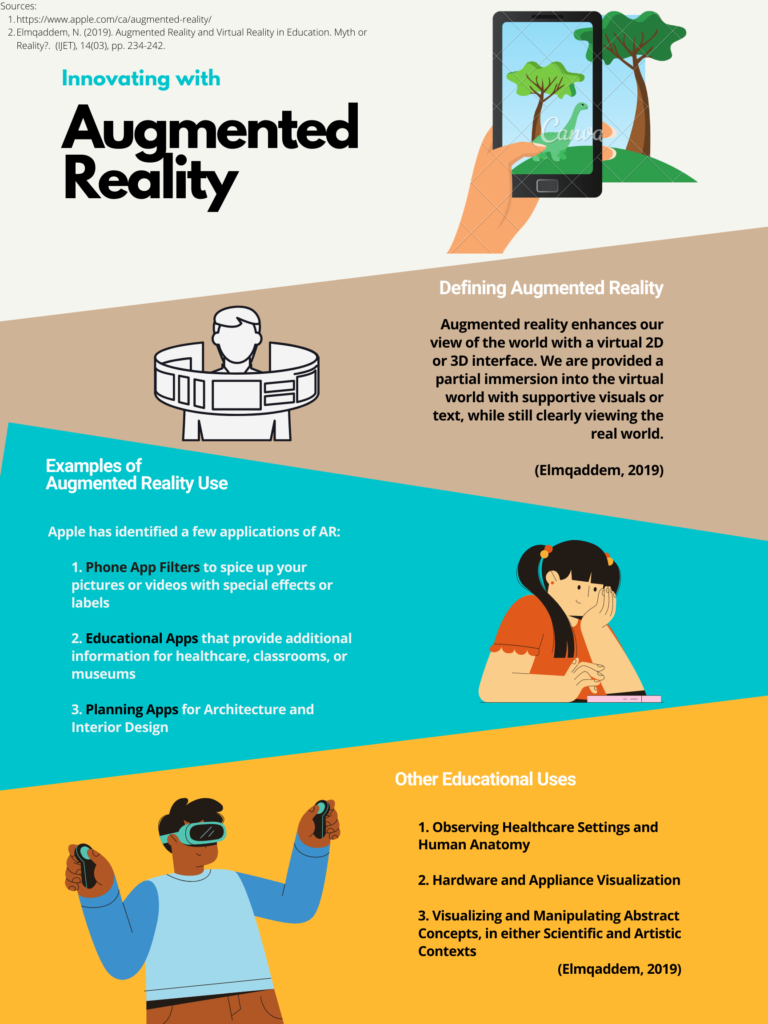The topic of this week’s blog post pertains to that of varying visuals that can assist or inspire in education. Infographics can act as visual posters or pictures that easily carry across ideas, Augmented Reality (AR) can enhance insights through changing our perception of the world around us, and Virtual Reality (VR) can show us entirely new sights. However, for all their new attention in the past few years, neither perception manipulating technologies are entirely new concepts (Elmqaddem, 2019). Both technologies were coined prior to the 21st century, though it is evident that they have become more popular and well-known in recent years (Elmqadeem, 2019).
AR & VR have both potential to enhance, innovate, and change how we educate and learn. AR & VR can bring to life visuals that textbooks or videos cannot hope to compare. AR especially may be appealing for classroom or class-style instructional settings as they would allow for just partial immersion into simulated reality while also keeping students grounded in the real world. Unlike virtual reality, which presents a completely simulated world, augmented reality only enhances or adds to the real world. AR would allow for an instructor to still be able to seen and more readily communicated with students.
Augmented reality also has benefits in lessening or tailoring the cognitive load that a learner may encounter during an educational setting, especially for younger children (Elmqadeem, 2019). AR can also help with ensuring the learning principles of motivation and freedom are maintained. Having greater freedom and control over the resources provided and controlled by AR can empower students to feel more confident while learning (OECD, n.d.). Self-control over how objects within AR can be interacted with also help learners be adaptable, an increasingly important skill in an ever-changing and cognitively demanding world (OECD, n.d.).
I believe that AR has much potential in its application in learning and viewing the world, especially in the many education settings it can be used in. I can imagine seeing AR glasses, apps, or headsets in classrooms, museums, exhibits, and workplaces in the next few decades. I’ve created a brief Canva poster to depict some current and potential applications of AR.

References:
Elmqaddem, N. (2019). Augmented Reality and Virtual Reality in Education. Myth or Reality?. International Journal Of Emerging Technologies In Learning (IJET), 14(03), pp. 234-242. doi:http://dx.doi.org.ezproxy.library.uvic.ca/10.3991/ijet.v14i03.9289
OECD. (n.d.). The Nature of Learning. https://www.oecd.org/education/ceri/50300814.pdf.
2021-05-29 at 1:09 am
Hi Allen,
You provided a very comprehensive introduction to AR and its potential to reshape education and student learning. I very much agree that different than VR’s completely simulated content, AR delivers partial simulation while still allow the users to be interacting with the real world. I also appreciate how you explained the various aspects of how AR benefits schools or other educational institutions, including being suitable for a classroom setting and providing learners with greater freedom over different resources. Throughout the post, you followed the Coherence principle and Pre-training Principle, where your main content and the infographic are very related and readers can find it easier to understand the information within the post. As a small piece of recommendation, perhaps the subtitles in the infographic could be more outstanding so they are more visually apparent.
Cheers,
Liyao
2021-05-31 at 10:19 am
Looks like you have navigated around Canva well. Good idea to use AR as your topic for the infographic.